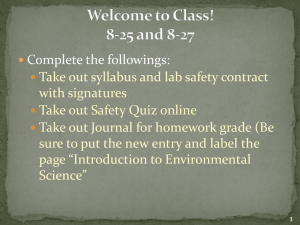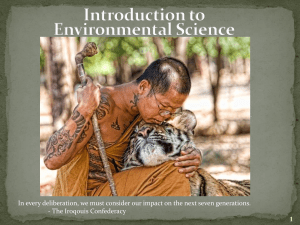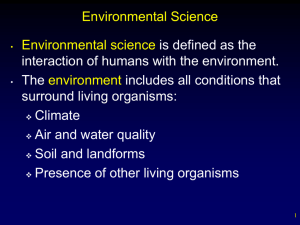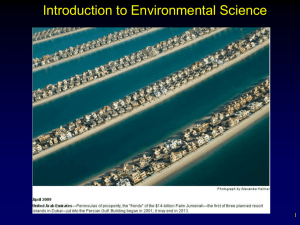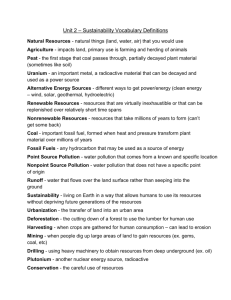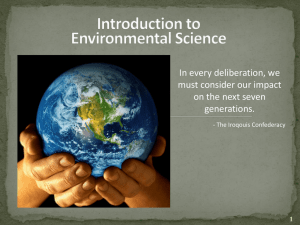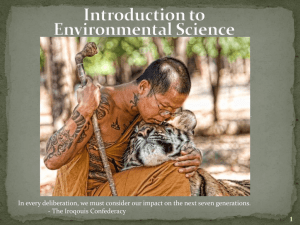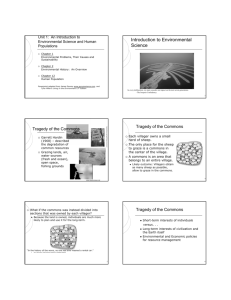Introduction to Environmental Science
advertisement
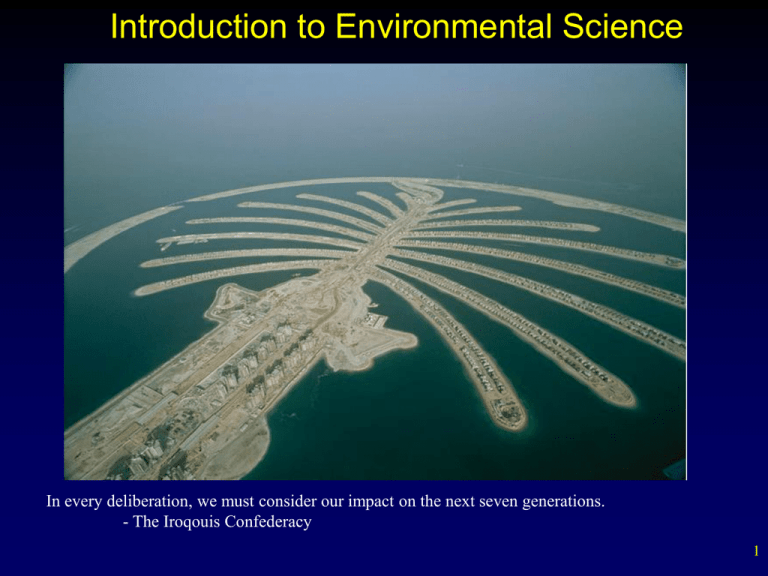
Introduction to Environmental Science In every deliberation, we must consider our impact on the next seven generations. - The Iroqouis Confederacy 1 Yosemite National Park • Yosemite National Park is a national park directly east of San Francisco that was created in 1890. Images taken from http://www.nps.gov 3 San Francisco • • • The city of San Francisco experienced a tremendous population boom in the 19th century due to the gold rush. A powerful earthquake struck the city in 1906, followed by a devastating fire. The city’s water pipes were so damaged by the earthquake, that firefighters were not able to tap fire hydrants. 4 Earthquake of 1906 • • The economic and structural damage to the city is comparable to that of Hurricane Katrina and New Orleans. As part of the rebuilding process, the city applied to the federal government to construct a reservoir in the Hetch Hetchy valley of Yosemite National Park. 5 Hetch Hetchy Valley Image taken from http://www.sierranevada photos.com • • San Francisco city officials wanted to dam the Tolumne river for a clean and dependable long-term water source for a growing city. An act of Congress and President Woodrow Wilson’s approval were needed for the dam and reservoir to be constructed. 6 Environmental Science • • Environmental science is defined as the interaction of humans with the environment. The environment includes all conditions that surround living organisms: Climate Air and water quality Soil and landforms Presence of other living organisms 7 Environmental Science Cont’d • Environmental science and the issues that it studies are complex and interdisciplinary. Includes concepts and ideas from multiple fields of study. Image taken from Principles of Environmental Science, Cunningham, 2005. 8 Decisions and Consequences • • Every decision that we as a society make has consequences for the rest of the planet. For example, using coal for electricity. The coal must be mined. When it is burned at a power plant, air pollution is released. Some of the pollution is converted to acid in the atmosphere. This falls as acid rain, stressing aquatic animals or plants. 9 Three Major Environmental Problems • Resource Depletion A great deal of resources are needed to support the human population (~7 billion). Renewable resources can be replenished within a human lifetime. - Timber, water. The supply of nonrenewable resources is not replenished as quickly, and can be used up. - Coal, oil, minerals. 10 Coal Reserves World coal reserves as of 2008. Estimated about 250 years at current rate of use. 11 Spaceship Earth • The Earth is a closed system. The only thing that enters or leaves the Earth in large quantities is heat. Resources are limited, but the population continues to increase. Wastes do not go away. 12 Major Environmental Problems • Pollution Pollution is a degradation; an undesired change in air, water, or soil that affects the health of living things. Biodegradable pollution will break down naturally over time. Nondegradable pollution does not break down. 13 Pollution • One of the biggest challenges with pollution is that it moves, affecting areas far away from the source. 14 Major Environmental Problems • Loss of Biodiversity The number of species on the Earth is unknown, but estimated to be in the tens of millions. Biodiversity is the number of different species present in one specific ecosystem. Extinction, or the complete loss of a species, is a natural event that can be accelerated by human actions. 15 Loss of Biodiversity • • Extinction is a normal event. The most recent major extinction, about 65 million years ago, caused 75% of all species to disappear from the Earth. Believed to have been caused by a meteor impact. 16 Loss of Biodiversity • • • Assuming no catastrophic events occur, extinctions occur at a pretty slow rate. Scientists believe we may be in the midst of the next major extinction event, due to human influences. Australia has experienced 27 mammal extinctions since 1788, primarily due to the influence of European settlers. The short-tailed hopping mouse, now extinct in Australia. Normal background extinction rate is 1 mammal every 200 years. 17 Environmental Ethics • Environmental ethics is the discipline that studies the moral relationship of human beings to the environment. • What is the value of the environment? What moral responsibility do we have in dealing with the major environmental problems? Which needs should be given the highest priority in our decision making? Two main catergories of ethics have emerged in human culture in modern history. 18 Anthropocentrism • Anthropocentrism literally means “humancentered”. This set of ethics protects and promotes of human interests or well-being at the expense of all other factors. Often places an emphasis on short-term benefits while disregarding long-term consequences. 19 Ecocentrism • • Advocated by John Muir, first president of the Sierra Club. Ecocentrists believe that nature deserves to exist for its own sake regardless of degree of usefulness to humans. The preservation of ecosystems or other living things takes priority over human needs. 20 Hetch Hetchy Debate • The debate about whether to build a dam in the Hetch Hetchy valley was one of the first big debates between these two philosophies. 21 Resource Conservationists • • The dam was eventually constructed. The justification for building it was best stated by Gifford Pinochet, the first man in charge of the U.S. Forest Service. "Where conflicting interests must be reconciled, the question shall always be answered from the standpoint of the greatest good of the greatest number in the long run.“ • This philosophy, called resource conservationism, was also advocated by Teddy Roosevelt. 22 Before and After 23 Resource Conservationists • • The focus of the resource conservationists was to protect open land. The National Parks system, and the National Forest system were both created during this time. 24 Modern Environmentalism • • In 1952, the Cuyahoga river in Ohio caught fire due to all the pollution that had accumulated in it. Rachel Carson published a book in 1962 entitled Silent Spring about the effects of pesticides on large predatory birds, particularly the bald eagle. This began a public awakening to threats of pollution and toxic chemicals to humans as well as other species. This is called the Modern Environmentalistm movement. 25 Global Environmentalism • Increased travel and communication enables people to know about daily events in places unknown in previous generations. Issues and problems are explored on a global scale instead of a local one. 26 The Environmental Conflict • • A great deal of progress has been made since the birth of modern environmentalism, but many debates still rage on. An ecologist named Garrett Hardin wrote an essay describing the source of environmental problems as a conflict: Short-term interests of individuals versus… Long-term interests of civilization and the Earth itself 27 Tragedy of the Commons • • Each villager owns a small herd of sheep. The only place for the sheep to graze is a commons in the center of the village. • A commons is an area that belongs to an entire village. Likely outcome: Villagers obtain as many sheep as possible, allow to graze in the commons. 28 • What if the commons was instead divided into sections that was owned by each villager? Because the land is owned, individuals are much more likely to plan and use it for the long-term. “In the history of the world, no one has ever washed a rental car.” Larry Summers, Chief Economic Advisor to President Obama 29 Economics and the Environment • Supply and Demand – The greater the demand for a limited resource, the higher the price. Examples: - Increasing price of oil/gasoline. - Consistently low price of corn in U.S. 30 Economics and the Environment • Cost/Benefit Analysis – Is the cost of doing something worth the price? Ex: Pollution cleanup of Waukegan Harbor Waukegan harbor Annual fish sampling Dredging 31 Economics and the Environment • Risk Analysis – The probability that something will cause injury or death. Ex: Nuclear power 32 Case Study: Bhopal and Dow Chemical • • In December of 1984, a pesticide factory located near the town of Bhopal, India leaked a large amount of toxic chemicals into the air. The chemicals resulted in an immediate death toll of about 3,000 people, with 8,000 more dying of long-term health ailments. A total of 558,125 injuries were reported to the Indian government. No legal settlement was reached with Union Carbide, now owned by Dow Chemical. 33 The Yes Men Fix the World. Dir Andy Bichlbaum, Mike Bonanno. Charny/Bacharach Entertainment, 2009. 34 Ethics and Economics • To properly compensate and treat all individuals affected by this disaster, Dow Chemical would have to pay several billion dollars in settlements. • Dow Chemical has a yearly profit of over $2 billion, with total assets worth nearly $70 billion. 35 The Demographic Divide: Developed and Developing Nations 36 Developed and Developing Countries • • Environmental issues faced by different countries varies depending on their economic status. Developed – Higher incomes, longer life span, lower growth rate. Ex: United States, Japan, France, U.K. 37 Developing and Developed Countries • Developing – Have lower incomes, shorter life span, rapid population growth. Ex: India, Afghanistan, most of sub-Saharan Africa 38 Population and Consumption • Developing countries tend to have severe overpopulation. This leads to: • Deforestation Bare soil Native animals driven to extinction Malnutrition, starvation, disease About 80% of the world’s population falls in this category Only use 25% of the world’s resources 39 Developing and Developed Countries Source: Holt Environmental Science, Arms, 2007 40 Population and Consumption • • Developed countries, while smaller in size and growth, consume resources at a greater rate. About 20% of the world’s population uses 75% of its resources. 41 Developing Countries • Many products used in developed countries are produced in developing countries. Working conditions and pay in these countries is often at levels that would be unacceptable elsewhere. Foxconn, a computer chip company, experienced a rash of suicides at its China factory 2010. 42 Example • StarKist brand chunk light tuna in water • American Tuna brand wild albacore tuna in water • Price at Jewel-Osco grocery: $0.99 Price at Whole Foods market: $4.99 What are the hidden costs behind that $4.00 price difference? 43 Ecological Footprint • An ecological footprint is one measurement of a person’s resource use. • Includes the amount of space needed to support each person in a nation, including forests, farms, cities, etc. Developed countries have a much larger footprint, reflecting a much larger use of resources. 44 The Goal: A Sustainable World • Sustainability Human needs are met so that the population can survive indefinitely. “Meeting the needs of the present without compromising the ability of future generations to meet their own needs.” - Brundtland Commission, 1987 45
